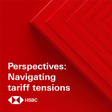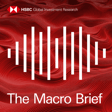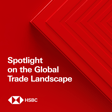Become a Creator today!Start creating today - Share your story with the world!
Start for free
00:00:00
00:00:01

Under the Banyan Tree - Asia awaits Trump’s call on tariffs
With President Trump’s 9 July tariff deadline looming, Fred Neumann takes a look at what US levies on Asian goods could mean for the region.
Disclaimer: https://www.research.hsbc.com/R/101/C7RfQkv. Stay connected and access free to view reports and videos from HSBC Global Investment Research follow us on LinkedIn https://www.linkedin.com/feed/hashtag/hsbcresearch/or click here: https://www.gbm.hsbc.com/insights/global-research.
Transcript
Introduction and Podcast Details
00:00:02
Speaker
Welcome to HSBC Global Viewpoint, the podcast series that brings together business leaders and industry experts to explore the latest global insights, trends, and opportunities.
00:00:13
Speaker
Make sure you're subscribed to stay up to date with new episodes. Thanks for listening, and now onto today's show.
00:00:23
Speaker
This podcast was recorded for publication on the 4th of July by HSBC Global Investment Research. Analystifications, disclosures and disclaimers must be viewed on the link attached to your media player.
00:00:35
Speaker
And remember, you can follow us wherever you get your podcasts. Just search for Under the Banyan Tree.
Fred Newman's Introduction and Initial Thoughts
00:00:50
Speaker
Welcome to Under the Banyan Tree, where we put Asian markets and economics in context. I say we, it's actually just me today, Fred Newman, Chief Asia Economist here at HSBC. And with Harold away, it's actually unusually quiet on our floor.
00:01:05
Speaker
He's on holiday and much of the office is away as well.
Impact of U.S. Tariffs on Asia
00:01:09
Speaker
But still, there's plenty to talk about with U.S. tariffs squarely back in the spotlight. Asia, along with the rest of the world, is waiting for President Trump to reveal the numbers next week. Let's take a closer look at what's in store.
00:01:22
Speaker
From HSBC Global Investment Research, you're listening to Under the Banyan Tree.
00:01:38
Speaker
Let's start with a recap on where we are in terms of U.S. tariffs and Asia. July the 9th is, of course, the day that President Trump will unveil the numbers for levies on U.S. imports from around the world. At least that's the purported deadline that could slip, of course. But right now, the two Asian economies in the spotlight are Vietnam and Japan. On Wednesday this week, Trump announced a deal that goods from Vietnam would face a 20% U.S. tariff, much lower than the 46% initially announced in April, although we still are waiting for confirmation from the Vietnamese government on this. But it could be a very different picture for Japan. Trump is threatening tariffs of up to 35% on Japanese goods, well above the 24% laid out on Liberation Day.
00:02:24
Speaker
He also says he's not convinced that a deal with Tokyo is likely before the July 9th deadline. So clearly plenty of moving parts as we move up to the deadline next week, although of course the deadline itself could slip. But we're already seeing really um sort of the wheels of negotiations ratchet up a little bit.
00:02:44
Speaker
um The latest announcements around Vietnam, of course, could be a blueprint for other nations, other economies in Asia as well. We might see some getting away with lower tariffs ultimately than what was threatened during the Liberation Day. But make no mistake, 20% tariffs on Vietnam is is still quite punchy.
00:03:04
Speaker
Some people would probably of you expect a bit less than that, but if we end up with 20%, the next big question is what do Vietnam's competitors face? If they come in around 20% as well, then probably disruptions for Vietnam are not too big.
00:03:18
Speaker
But if we see other economies, let's say Mexico ultimately under the USMCA deal or Malaysia or India come in with much lower tariffs, that would obviously be a headwind for Vietnam.
00:03:32
Speaker
um But so far, I think 20% is probably manageable for the Vietnamese economy. They're still hugely competitive. Labor costs there lower than they are in China at the moment. and Still a lot of kind of industry settled in Vietnam already. They have a lot of economies of scale, so probably can take 20% their
Vietnam's Tariff Strategy and Challenges
00:03:51
Speaker
stride.
00:03:51
Speaker
in their stride As we wait for for all of these trade deals to fall into place, ah there's another issue here that's relevant for the region, and that is that according to some of the reporting, Vietnam is also committing itself to a 40 percent tariff on re-exports to the United States. now This doesn't mention specifically mainland China, but of course, because many mainland Chinese goods are finding the way to the U.S. market via Vietnam, it's probably safe to assume that this 40% tariffs is really aimed at keeping Chinese re-exports out of the U.S. market.
00:04:30
Speaker
So in in many ways, if that only applies to re-exports, that's probably something that wouldn't be too disruptive. The question is, really, will this apply China? Chinese components that find their way into Vietnamese production and at what rate, at what contribution to this production will really the 40% apply.
00:04:51
Speaker
Because in many ways, China is dominant globally in terms of its component supplies into supply chains. Vietnamese industry along with many other industries and other economies use Chinese components. And so the degree of disruption really depend on how this particular provision of a 40% tariff is applied. Does it apply to every single component in these goods or is there a fairly high threshold? And I think there is still a lot to be are really filled out in terms of the fine print of this particular deal.
00:05:23
Speaker
So as of now, we still have a lot to play for. We really have to see how exactly these ah deals come in, what individual economies are signing up.
Japan's Tariff Negotiations and Trade Concerns
00:05:33
Speaker
The other one that was in the news this week is Japan.
00:05:35
Speaker
Japan reportedly holding out. We thought initially Japan would come in with a deal more quickly than other nations, but it's been hard to get this deal with Japan over the line. And the sticking point reportedly is really auto tariffs. Japan is a major exporter of cars to the United States.
00:05:54
Speaker
Japan has really sought a 10% tariff down from about 25% now. ah Currently, that's being imposed by the US on imports from Japan on cars. But that's sort of the sticking point. And so we've not gotten a deal yet.
00:06:09
Speaker
Trump has threatened a 35% blanket tariff on Japan, which would have a major impact on the economy. now One of the reasons why Japan may be slower to actually get a deal is because we're facing elections in Japan as well, and upper house elections soon. And so there's probably a desire on behalf of the Japanese government to not essentially give in too quickly to any demands by the Trump administration.
00:06:31
Speaker
So, where are we here in deals? Well, a lot to play for. ah Probably July 9th will give us a bit more clarity, though some of the fine print will need to be filled in later. um Often it depends not just assessing the impact, not just what happens on individual economies, but also how do economies stack up relatively to each other. So we're watching that. um A few other things really to mention on
U.S. Importers and Supply Chain Reconfiguration
00:06:57
Speaker
the trade front. One is that the front loading of shipments has been huge. And if you just look at the data at the moment, you might conclude, well, the tariffs haven't had so far a big impact on trade. But the reality is,
00:07:08
Speaker
that we have seen major, major front-loading as U.S. importers in particular are worried about tariffs only rising over time and sort of accelerated purchases.
00:07:19
Speaker
and And we know, for example, that U.S. retailers have ah essentially um increased their orders of of Asian goods and they've essentially brought forward into the second quarter of this year all the purchases leading up to the Christmas shopping season. So that rather than seeing a big bulk of those shipments coming through, in September, August and September, that usually leads into Christmas period. That's now been stuffed into the second quarter.
00:07:45
Speaker
And that's why you see this massive front-loading, exports still rising and in most economies. But of course, regardless of whether we get tariffs or not, there's going to be some payback. And so ah probably second half of the year, you're going to see a major slowdown in shipments, particularly from the US retail side actually cooling things down. And that, I think,
00:08:04
Speaker
will contribute to broader economic slowdown across the region. um And then by early next year, we then have to assess how binding the tariffs really are on future trade. And it looks as if average tariffs in the US are going to be higher than anything we've really seen since the nineteen thirty s and so Even though there's optimism right now that, well, Asia could probably digest some of these tariffs, we have to recognize that fundamentally, tariffs do mean lower demand by the U.S. for Asian goods over time. And so there is going to be some growth headwind we need to grapple with.
00:08:39
Speaker
um The last point really to make is what does all this mean for future supply chains? And you know it's tempting to think that some of the supply chains will just move back to Europe and the US as a result of all this trade uncertainty, etc. I think we need to be a bit careful.
00:08:57
Speaker
about this assumption in part because the manufacturing capacity just doesn't exist in in both the US and in Europe in terms of labor supply, for example, in terms of just supplier networks. And so um while some industries might move back into the US, I think a lot will remain stuck in Asia. And it's even with China, it's very hard to see China being completely taken out of global supply chains just because they're hugely competitive and they're number one component supplier now globally, very hard to be on price and quality.
00:09:33
Speaker
And so what this means is that we might see a bit of a reconfiguration here as tariffs come in. We might see more more assembly being distributed across ah more countries.
00:09:45
Speaker
There might be a lot of tariff arbitrage that comes in. Technically in economics, we call this trade diversion rather than trade destruction. So there's still going to be a lot of trade, but it's going to be diverted into other economies with reassembly moving, being distributed so ah that individual companies can A, reduce risk against future tariffs by having more distributed production centers, but also kind of a tariff arbitrage game that's that's coming in here. Just a side note, of course, by tariff arbitrage, we mean the fact that
00:10:17
Speaker
If different economies have different levels of tariffs for certain goods, then you might see essentially companies shift shipping goods between those countries to avail themselves of essentially the cheapest tariff before exporting to the United States. And and this is this is fair game. This is common practice. now what happened to ah really since the Second World War, is that tariff levels globally came down. There was less scope for arbitrage because really tariffs are more or less the same.
00:10:46
Speaker
Now, as we see different countries facing different tariffs, not just on average, but for individual goods as well, you might see essentially companies moving goods more between economies just to kind of eke out those gains where they can find a niche where they can export at the lowest tariff rate to the United States.
00:11:05
Speaker
Now, this is suboptimal for the global economy, probably means higher costs on average for manufactured goods. But it also means that we're not seeing the wholesale kind of taken out of supply chains out of Asia. Asia will remain of dominant in in most of this manufacturing, but probably the cost of manufacturing goods for the end consumers ah will increase slightly for Western consumers.
00:11:28
Speaker
So, folks, lot to play for over the coming week. and We have a big tariff deadline coming up. you know The deals are supposed to be announced. There could be a risk that some of these deadlines slip.
Conclusion and Contact Information
00:11:38
Speaker
But generally speaking, we'll have a much better view of where we land in terms of tariffs for most of Asia.
00:11:44
Speaker
China is actually a bit excluded because China's tariff deadline is actually a little bit later. It's in August. But for most of the rest of the region, we should have a clearer picture. But remember, It's not just about individual countries' tariffs, it's also about the relative tariffs, and it's about some of the fine print when it comes to re-exports.
00:12:05
Speaker
And also, of course, ultimately, we have to remember that even if tariffs come in, Asia remains overall vastly competitive when it comes to production of goods and components, including China. So most likely what we'll end up with is a spaghetti bowl of different tariffs and different trade routes and companies trying to kind of get an advantage here and there by moving from one economy to another and arbitraging essentially a tariff rate.
00:12:34
Speaker
ah It's going to be more complicated, but fundamentally, Asia will remain the manufacturing powerhouse of the world.
00:12:42
Speaker
That's all we've got time for today, folks. Many thanks for joining us and do get in touch at askresearch at hsbc.com with any questions or comments on this week's episode.
00:12:53
Speaker
We'll be back again next week, so be sure to tune in wherever you get your podcasts, whether you're in the office or poolside on vacation. Take care and talk to you very soon.
00:13:36
Speaker
Thank you for joining us at HSBC Global Viewpoint. We hope you enjoyed the discussion. Make sure you're subscribed to stay up to date with new episodes.
















